Ranch horse pleasure has an undeniable draw for Western riders of all kinds. Not up for spending a fortune on sparkling tack and attire? You don’t need to. Not into artificial grooming, banding, and polishing? It’s not required here. Have a horse without designer bloodlines? No problem. This class is all about your horse’s natural ability to work each part of the pattern correctly and efficiently under your guidance. And because it’s a scored event, you can compete against yourself, striving to improve your overall score or certain maneuver marks each time you go in front of a judge.

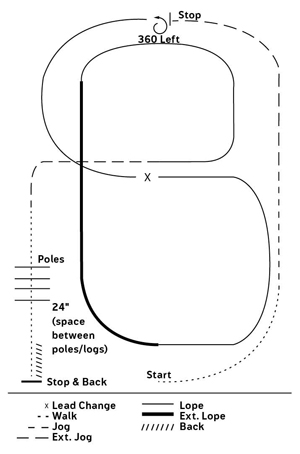
Here, I’ll break down each maneuver to help you get your horse shown the best you can when working AQHA Pattern 1 in the ranch horse pleasure class.
Maneuver 1: Walk
When you walk into the arena, consider yourself “on pattern” as you enter the gate. Walk through the gate, and keep moving. That way, you won’t have to rush into the corner that’s on your right. Be sure that your horse is moving forward freely and that he’s focused on his job; not looking at what’s on the other side of the arena. The judges want to see a comfortable horse moving at a walk, focused on what he’s doing.
Maneuver 2: Jog
The transition to the jog can happen anywhere as you come out of the corner. That’s the beauty of these patterns: You can use your discretion and show off your horse’s best attributes. If he has a great walk, go a few strides past the corner; if not, pick up the jog just as you come out of the corner. When you accelerate to the jog, it should be forward and free, not forced, and with no resistance from your horse.
Maneuver 3: Extend the Jog; Stop at Top of Arena
Halfway down the long wall of the arena, you’ll need to extend the jog. You can post the extended jog (you don’t need to worry about which diagonal you’re on), stand in your stirrups with or without holding the horn, or sit the gait. The extended jog should be forward, but not feel forced or rushed. Think about trotting cross-country to get someplace, but without feeling like you’re being chased. When you ask for the stop, rather than use your hand, sit down, quit riding, and settle your energy for a square, peaceful stop. Take a moment for a breath here.
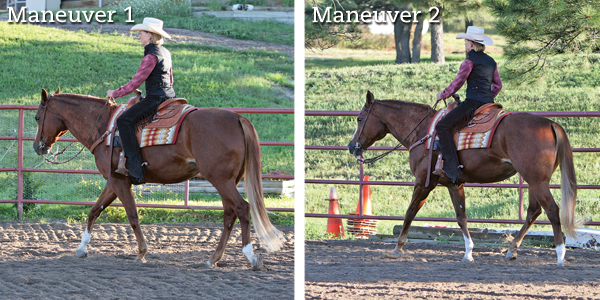
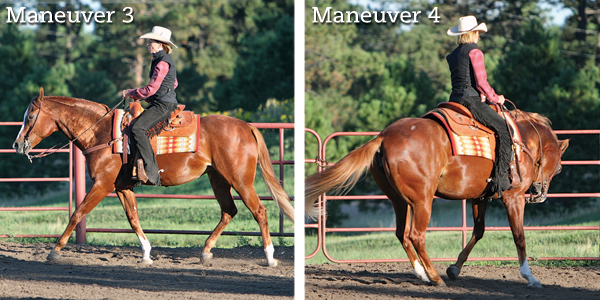
Maneuver 4: 360 to the Left
I see lots of amateur riders rush through the turn. They stop and want to hustle around the turn, but the result is that it looks messy and more complicated than it needs to be. Make a steady, efficient, mistake-free turn to the left.
Maneuver 5: Left-Lead Half-Circle; Lope to Center
For the left-lead departure, you can walk a step out of the turn and then lope or lope right out of it, depending on your horse’s skills. If your horse can lope right out of his turn, that momentum will help him flow into a nice lope step. The pattern shows that you should lope a half circle, and then change leads near the center of the arena.

Maneuver 6: Change Leads (Simple or Flying)
Don’t anticipate the lead change; take your time. If you’re schooling at a show, go one or two strides past center to avoid anticipation. But if you’re hunting for points, be sure to execute the lead change at the center of the arena. You can complete a simple or flying lead change, whichever best suits your horse’s skill set.
Maneuver 7: Right-Lead Half-Circle
On the pattern, the right-lead half-circle has somewhat square corners; you should execute them that way. It adds a degree of sophistication and elegance, as well as sets your horse up to be straight through his body rather than lean out of alignment.
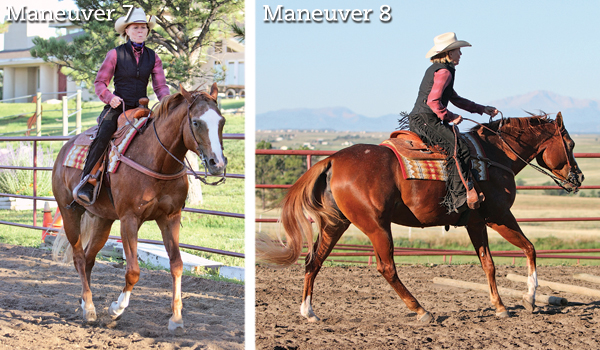
Maneuver 8: Extended Lope
When you extend the lope near the bottom of the pattern, make a deliberate effort to pick up the pace, but don’t go to an all-out gallop or let your horse run off. Strive for a controlled build of speed over a couple strides. Be sure to come to your full pace before you come out of the corner.
Maneuver 9: Collected Lope; Return to Center
As you return to the collected lope, be precise. You should return to the slower gait over the course of two strides and show that you’re in control. Don’t break gait or change leads behind, two common problems I see during this transition. Notice that the corners are square on this portion of the pattern, too.
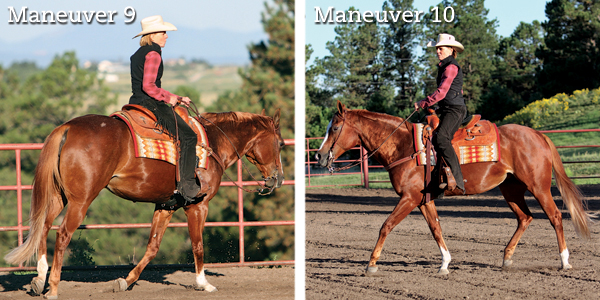
Maneuver 10: Extended Jog
Lower your energy, and sit through the transition to the extended jog, but don’t relax so much that your horse drops to a jog or walk. I advise sitting through the transition, then standing in your stirrups or posting once you’ve slowed to the extended jog. You have plenty of time for this transition; don’t rush it.
Maneuver 11: Walk Over Poles
Drop to a walk with enough space for your horse to see the poles. This is the only place in the pattern that I advise putting your hand forward to put slack in the reins, so your horse can see the poles. However, don’t go as extreme and dramatic as in the trail class with your rein drape or with your horse putting his head way down to look at the poles. There are a couple tricks to get through the poles without rubbing or hitting them. First, strive to have your horse’s first foot land 6 inches in front of the first pole. (Do this by practicing at home.) If you find this spot, your horse will do his best to carry you through the poles. Second, don’t stop riding before your horse’s last foot is over the final pole! I see too many riders sit down and shift their energy before the last foot has completed the obstacle.

Maneuver 12: Stop and Back
After your horse’s last foot has cleared the final pole, move right into your walk. If your horse has a strong walk, go as far as you can before you stop and back. If it’s weaker, just get in the few strides required. In either case, keep your horse straight so that he can back a straight line. For the backup, be sure your horse is soft in the bridle—not gaping his mouth or bracing—and go eight to 10 steps backward. Acknowledge the judge, and exit the arena.
Bill Bormes trains open and amateur horses in Elizabeth, Colorado. He’s shown open horses and coached amateur riders to great success in the ranch horse pleasure classes, including the 2012 and 2013 open ranch horse pleasure year-end high-point winner, Lavish Love, owned by Ann Hards.






